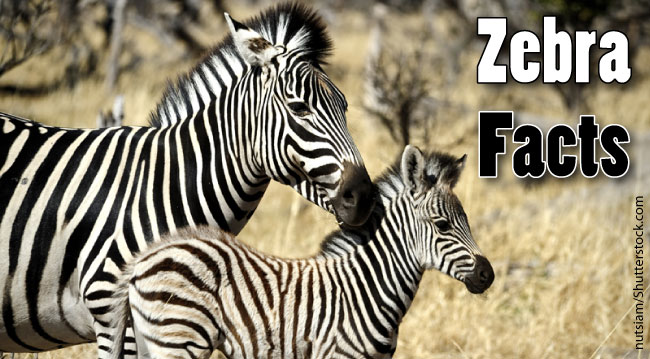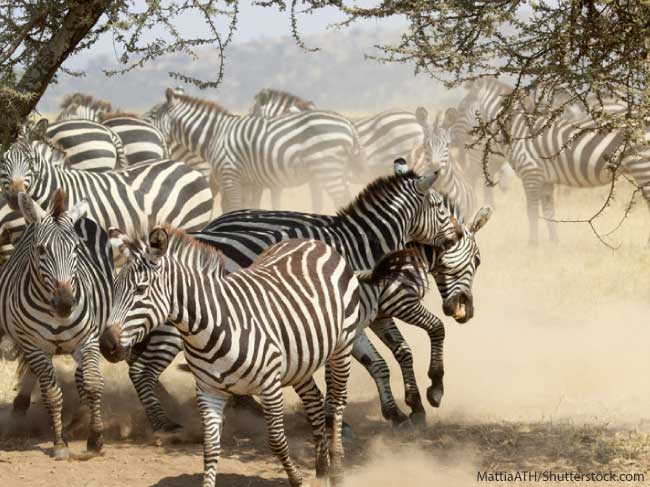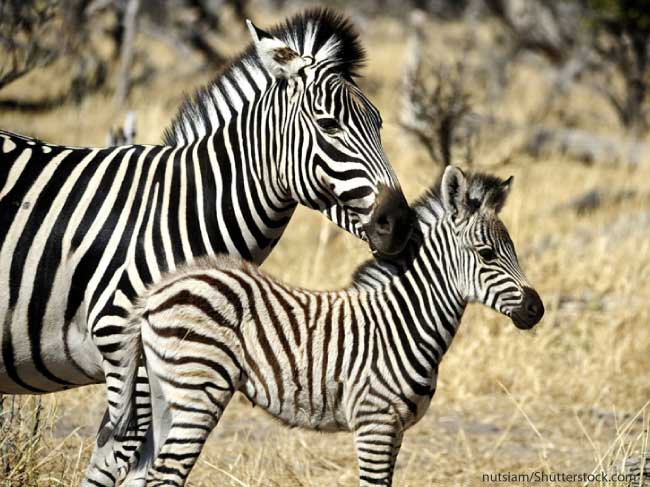Zebras are some of the most recognisable animals in the world. Most children will be able to identify this distinctive member of the horse family by its black and white stripes. This page contains zebra facts for kids and adults, and is part of our African Animals series.
Zebra Facts For Kids
Zebras are a group of several species of African equids (members of Equidae, the horse family).
Zebras are highly distinctive due to their black and white striped coats. They are generally social animals that live in a wide range of organisations from small harems to large herds.
There are 3 species of zebra: the plains zebra (Equus quagga), the Grévy's zebra (Equus grevyi) and the mountain zebra (Equus zebra).
The Plains zebra is the commonest and most widespread zebra species.
Where Do Zebras Live?
Zebras live in southern and eastern Africa.
Grevy’s zebras live in semi-arid grasslands and sub-deserts in Ethiopia, Somalia and Kenya.
Mountain zebras (as their name suggests) inhabit rocky, arid slopes in Angola and Namibia.
The Plains zebra's range stretches from the grasslands of East Africa to the scrubby woodlands of southern Africa.
Appearance
Zebras are 4.2 to 5 ft (1.3 to 1.5 m) tall and weigh 550 to 990 lb (250 to 450 kg). Grevy’s zebra is the largest and the plains zebra the smallest. Their distinctive stripes differ between the 3 species. The Grevy’s zebra has the thinnest stripes which extend all the way down to their white belly; on the hindquarters, the stripes are vertical until above the hind legs. The mountain zebra has vertical stripes on their neck and torso, but horizontal stripes on their haunches. Scientists argue that zebra have white coats with black stripes. This is because the stripes end on their belly and toward the inside of the legs, and the remainder is all white.
There are several possible functions of the stripes. One of these is protection from predators; when they are in a group, their combined stripes make it difficult for predators to single out just one zebra to chase.
You can see just how large a zebra herd can be in the video below. Listen out for the strange sounds that zebras make.
Defence
Like horses, zebras have four gaits, i.e. walk, trot, canter and gallop. Zebras are generally slower than horses but can still run at speeds of up to 35 mph (56 kph). Often, the lead stallion sounds an alarm when danger is spotted and then stays at the rear of the herd or group to defend against predators and allows the mares and foals to escape. When chased, zebras often zig-zag from side to side, making it much more difficult for predators to catch them. Zebras usually rely on their great stamina to outrun predators, but if they are cornered, they will rear up and kick or bite the attacker.
Diet and Feeding
Zebras feed almost entirely by grazing on grasses, but sometimes browse on leaves, herb, shrubs, twigs and bark. They have a highly adapted digestive system which allows them to live on diets of very low nutritional quality.
Zebra Families
Zebra females (mares) can usually have their first foal when they are 3-years-old. Males mature much more slowly and are not able to breed until the age of 5 or 6. Females are pregnant for 12 to 14 months and can give birth to 1 foal every 12 months. Newly-born foals are precocious, i.e. they are able to stand, walk and suck milk soon after birth, and weigh 55 to 88 lb (25 to 40 kg) at birth. Foals are weaned after about a year.
Because of their different social organisations, plains and mountain zebra foals are defended by both the herd mares and the head stallion, whereas Grévy's zebra foals are defended only by their mother. Zebra foals are born brown and white instead of black and white. A foal learns its mother’s stripe pattern so they can follow her. Zebras can live up to 25 years.
Are Zebras Endangered?
The mountain zebra and Grévy's zebra are endangered. The plains zebra is much more plentiful, although one subspecies, the quagga, became extinct in the late 19th century.
Quick Zebra Facts For Kids
- Unlike their closest relatives, horses and donkeys, zebras have never been truly domesticated.
- Like horses, zebras sleep standing up, but may sometimes sleep lying down while another zebra stands nearby as a sentinel.
- Zebras reinforce their social bonds by grooming each other.
- Zebra foals can walk just 20 minutes after birth and can run after an hour!
- A zebra's eyesight at night is thought to be about as good as that of an owl.
- A subspecies of the plains zebra, the Grant’s zebra, is famous for its spectacular migrations; 10,000 of these animals journey together in congregated herds.
- Different zebra species have different widths of stripes - the further south on the African plains, the farther apart the stripes on the zebra!
- Zebra stripes are unique to each individual, just like fingerprints on humans.
- Zebras have a pad of fat under their mane. This keeps it standing straight up.
- Zebras have black skin under their white coats!
Zebra Facts For Kids Conclusion
We hope that you have enjoyed these zebra facts. You can find out about many other incredible African animals here: African Animals.






